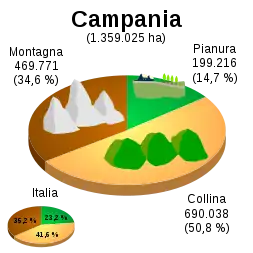
The geography of Campania illustrates the geographical characteristics of Campania, a region of Italy.
General data
From the gulfs of Gaeta, Naples, Policastro and Salerno to the most notable elevations of the Campania Apennines, Campania extends over a morphologically very varied territory. To the north it borders Lazio and Molise; to the east, Apulia and Basilicata, which it also borders to the south; to the west the Tyrrhenian Sea.[1]
Areas
From a physical point of view, the Campania region can be divided into two areas: one mountainous and one flat:[2]
- The mountainous area includes the Campania Apennines, formed by a series of elevations, acrocores and plateaus (of Sannio, of Irpinia and of Cilento), between which open numerous and easy passes (the most important is the Sella di Ariano) and there flows the river Calore Irpino (left tributary of the Volturno) with its tributaries: Ufita ( in the center of the homonymous valley), Tammaro and Sabato.[3]
- The flat area is not a single surface, but is divided into many plains divided by many reliefs of the antiappennine; that is from the volcanic relief of Roccamonfina, of the Campi Flegrei, from Vesuvius and from the chain of Monti Lattari (which constitutes the Sorrento peninsula).[2]
Therefore the flat area is divided into the plains: of Sessa Aurunca,[4] bathed by the river Garigliano;[5] of Capua the widest, crossed by the river Volturno; of Naples, which surrounds Vesuvius, one of the main Italian volcanoes; the countryside nocerino - sarnese close to the Lattari Mountains; of Paestum which opens onto the Gulf of Salerno and is bathed by the rivers Sele, Calore Lucano and Tanagro; of Alento which occupies a narrow portion between Monte Stella[6] and Monte Gelbison.[7]
Coasts and rivers
The coasts of Campania are high and jagged and low and sandy in the plains. The main rivers are: the Volturno, which bathes Capua and flows into the Gulf of Gaeta; the Sele, which flows into the Gulf of Salerno; the Garigliano, which flows along the border with Lazio and flows into the Gulf of Gaeta; and the Ofanto, which originates in Irpinia and flows into the Adriatic Sea.[1]
Mountains
References
- 1 2 "Campania, Scheda Regione - Global Geografia". www.globalgeografia.com. Retrieved 2021-03-01.
- 1 2 "Campania". www.schededigeografia.net. Retrieved 2021-03-01.
- ↑ "Delibera della Giunta Regionale n. 175" (PDF). ministroperilsud.gov.it. 2018-03-28. Retrieved 2021-03-01.
- ↑ "Dossier del Sistema Locale di SESSA AURUNCA, Provincia di Caserta" (PDF). reterurale.it. Retrieved 2021-03-01.
- ↑ "LA CAMPANIA" (PDF). icnova.edu.it. Retrieved 2021-03-01.
- ↑ "TRAVERSATA MONTE STELLA - Outdoor Campania - associazione di turismo escursionistico e ambientale". www.outdoorcampania.it. Retrieved 2021-03-01.
- ↑ "Natura Italia - Area Naturale". www.naturaitalia.it. Retrieved 2021-03-01.
